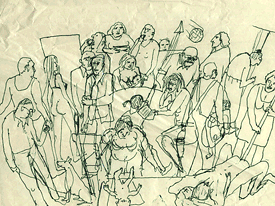Rothera | Interactive Project | Recreating “Tango” by ZBIGNIEW RYBCZYNSKI
I have always been interested in performative artwork, especially work that is both playful or technologically engaging, but also speaking to something greater than the individual performance.
McLaren’s work is great. He has a mastery of animation timing. In my favorite piece “Canon” McLaren confuses the audience first before revealing the pieces composition. And just before the viewers fully grasp the rhythm and situation, he ends the performance.
I am very attached to recreating “Tango” in hopes of collaborating with ZBIGNIEW. At the time he was working at the edge of technology to produce this piece through compositing and meticulous planning. But I feel the true strength of “Tango” is in this idea of transient space. Each ‘performer’ is unaware of one another and continues their life without care or contact with another person.
Why is this re-performance important:
My version is important because I will be able to computationally incorporate involuntary viewers into the piece. I imagine this piece being installed in a room or common place. My work differs in that the software will look for people and walking paths that can be incorporated into a looping pattern in a way that they never collide with each other. Like Zbigniew my goal is to fill an entire space in which participants do not see each other, nor collide.
Tech/learned skills:
-Potential and importance of kinect imaging as opposed to standard camera vision for tracking.
-Kinect’s ability to tag/track people based on body gestures.
-How to organize 3D space in 2D visualization.

“Tango” by ZBIGNIEW RYBCZYNSKI

http://vodpod.com/watch/3791700-zbigniew-rybczynski-tango-1983
[youtube http://www.youtube.com/watch?v=pTD6sQa5Nec&w=960&h=720]
[youtube http://www.youtube.com/watch?v=rBZrdO3fU8Y&w=640&h=360]
[youtube http://www.youtube.com/watch?v=Ib_X7PDfx4E&w=640&h=480]
[youtube http://www.youtube.com/watch?v=kZQ11VhXCP8&w=640&h=360]


Those are some really cool inspirational pieces! Never seen anything like that before.
Nice motivation, ok.
really cool concept, i like the process a lot. reminds me a bit of how they time military attacks with this marathon type people doing all of their tasks in a certain amount of time and passing to the next person. maybe looking into that process would help generate some idea of how to track/map people passing with colliding as well.
NIce documentation of your background research. Great idea to redo somthing under the light of new technology.
Up front: I recommend clearly state: I am making an authoring system for the design of spatiotemporally interlocking performances, such as Rybczinsky/McLaren.
Would love to see some sketches to articulate your final vision. Are you planning to mask out the backgrounds around each figure and then composite the figures in the same space? I love the idea of a public hallway installation.
maybe you could project the previous locations on the floor so it would be easier to come up with non-intersecting paths. you could also store many paths and fit them together algorithmically as you find new possible matches rather than just storing one single combination.
I’m curious about mapping people into a grid. Did you use the grid mainly because it was the easiest to implement or is there something more important about it? If you just want to check for collisions, you could probably place circles at arbitrary 2D locations and use any physics system or code that’s easily available online to check for collisions. << im wondering this as well, why not just check the z postion on the fly whenever 2 characters overlap? Oh, maybe because people have depth...? If you are looking to get lots of paths working together, having fine-grained collision detection is important and I think that eventually the grid will be limiting. Great idea. I worry that trying to automatically pack people into the space is too hard to solve computationally, so maybe adding a little human input to help ease that problem might help you create finished products. I think this is basically what Golan was getting at regarding building tools. But I really like the idea that every day in a gallery a new one of these is generated by by everyone that visits the gallery. Amazing idea. I hope you will finish this! ** yes, please do. Pretty awesome process! Sounds like you are on your way Awesome stuff. Really enjoyed the background information. Looking forward to seeing more. Please make some (provocative, fun, interlocking) videos with this tool.